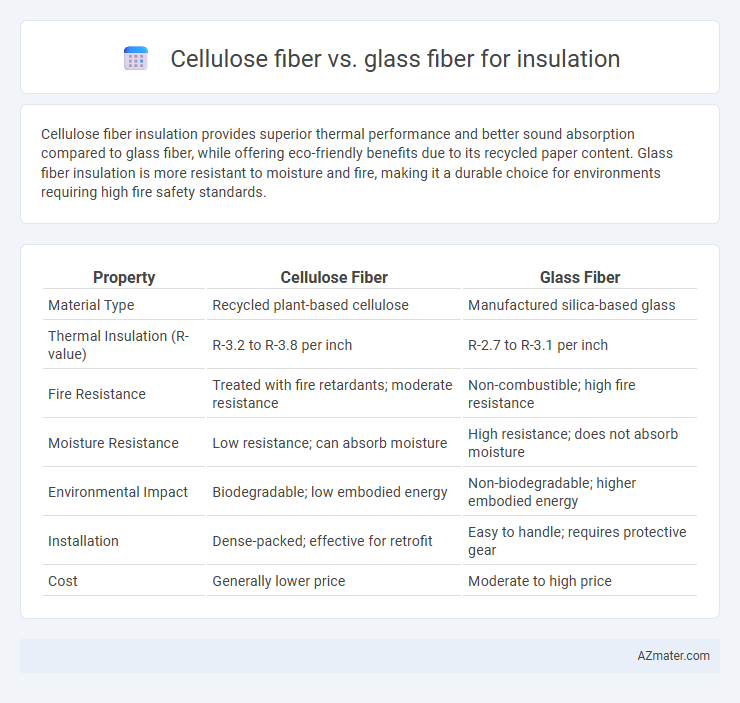Cellulose fiber insulation provides superior thermal performance and better sound absorption compared to glass fiber, while offering eco-friendly benefits due to its recycled paper content. Glass fiber insulation is more resistant to moisture and fire, making it a durable choice for environments requiring high fire safety standards.
Table of Comparison
| Property | Cellulose Fiber | Glass Fiber |
|---|---|---|
| Material Type | Recycled plant-based cellulose | Manufactured silica-based glass |
| Thermal Insulation (R-value) | R-3.2 to R-3.8 per inch | R-2.7 to R-3.1 per inch |
| Fire Resistance | Treated with fire retardants; moderate resistance | Non-combustible; high fire resistance |
| Moisture Resistance | Low resistance; can absorb moisture | High resistance; does not absorb moisture |
| Environmental Impact | Biodegradable; low embodied energy | Non-biodegradable; higher embodied energy |
| Installation | Dense-packed; effective for retrofit | Easy to handle; requires protective gear |
| Cost | Generally lower price | Moderate to high price |
Introduction to Cellulose and Glass Fiber Insulation
Cellulose fiber insulation, made from recycled paper products treated with fire retardants, offers eco-friendly thermal and sound insulation benefits with high density that minimizes air leakage. Glass fiber insulation consists of fine glass strands woven into mats or loose-fill, providing excellent thermal resistance, moisture resistance, and non-combustibility. Both materials serve as effective insulation solutions with distinct advantages related to sustainability, fire safety, and installation versatility.
Composition and Manufacturing Process
Cellulose fiber insulation is primarily composed of recycled paper products treated with flame retardants, while glass fiber insulation consists of fine strands of molten glass spun into fibers. The manufacturing process for cellulose involves shredding and chemically treating paper materials to enhance fire resistance and pest deterrence, contrasted with glass fiber production that melts raw silica sand and other minerals at high temperatures before drawing them into fibers. These compositional and manufacturing differences influence the thermal performance, environmental impact, and installation characteristics of the two insulation types.
Thermal Performance Comparison
Cellulose fiber insulation offers a thermal conductivity typically around 0.038 to 0.040 W/m*K, providing effective heat resistance and superior air sealing due to its dense, fibrous structure. Glass fiber insulation generally has a thermal conductivity between 0.035 to 0.042 W/m*K, with performance influenced by fiber diameter and density, often resulting in slightly lower R-values per inch compared to cellulose. While both materials provide robust thermal performance, cellulose's ability to reduce air infiltration enhances its overall insulation efficiency in building envelopes.
Energy Efficiency and R-Value
Cellulose fiber insulation offers superior energy efficiency due to its excellent air-sealing properties and a typical R-value of around 3.2 to 3.8 per inch, providing effective thermal resistance. Glass fiber insulation, with an R-value ranging from 2.9 to 3.7 per inch, is less dense and allows more air infiltration, reducing its overall energy efficiency in comparison. Choosing cellulose fiber enhances thermal performance and reduces heating and cooling costs by minimizing heat transfer and improving airtightness.
Soundproofing Capabilities
Cellulose fiber insulation excels in soundproofing due to its dense, fibrous structure that effectively absorbs airborne noise and reduces sound transmission between rooms. Glass fiber insulation also offers soundproofing benefits, but its looser composition typically allows more sound to pass through compared to cellulose. For optimal acoustic performance, cellulose fiber is often preferred in residential and commercial applications where noise reduction is a priority.
Fire Resistance and Safety
Cellulose fiber insulation, made from recycled paper treated with fire retardants, offers moderate fire resistance but can smolder under high heat, requiring proper chemical additives for safety. Glass fiber insulation is inherently non-combustible, providing superior fire resistance and preventing flame spread, making it a safer choice in fire-prone environments. Both materials must meet building codes, but glass fiber's inorganic composition generally ensures enhanced fire safety performance.
Environmental Impact and Sustainability
Cellulose fiber insulation is made from recycled paper products, offering a biodegradable and renewable option with significantly lower embodied energy compared to glass fiber, which is produced from silica sand and requires high-temperature melting processes resulting in higher CO2 emissions. Cellulose fiber's ability to be recycled and its lower environmental footprint contribute to enhanced sustainability, whereas glass fiber insulation has a longer lifespan but involves energy-intensive manufacturing and challenges in recyclability. Choosing cellulose fiber supports circular economy principles and reduces landfill waste, while glass fiber's inertness can pose environmental disposal concerns.
Cost Analysis and Affordability
Cellulose fiber insulation typically costs between $0.60 to $1.20 per square foot, making it more affordable than glass fiber, which ranges from $0.80 to $1.50 per square foot. The lower manufacturing expenses and use of recycled paper in cellulose contribute to its cost-effectiveness, whereas glass fiber requires higher energy inputs and raw materials. Homeowners seeking budget-friendly insulation often favor cellulose fiber due to its competitive pricing and environmental benefits.
Installation Methods and Ease
Cellulose fiber insulation is typically blown or sprayed into wall cavities and attics, requiring specialized equipment but allowing for easy adaptation to irregular spaces and retrofits. Glass fiber insulation commonly comes in batts or rolls, which can be manually fitted into framing spaces, offering straightforward installation for standard-sized cavities but less flexibility in uneven areas. While cellulose demands professional handling due to dust and moisture sensitivity, glass fiber provides a simpler, do-it-yourself friendly process with minimal preparation.
Longevity and Maintenance Requirements
Cellulose fiber insulation offers excellent durability when installed correctly, resisting pests and mold with minimal maintenance, but it may settle over time, requiring periodic top-ups to maintain effectiveness. Glass fiber insulation boasts superior longevity, remaining stable and effective for decades without significant degradation, and requires virtually no maintenance once installed. Both materials provide reliable thermal performance, yet glass fiber's inert composition ensures consistent insulation properties, while cellulose benefits from eco-friendliness and ease of repair.

Infographic: Cellulose fiber vs Glass fiber for Insulation
 azmater.com
azmater.com